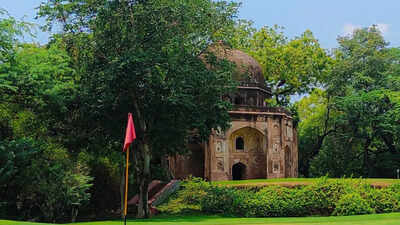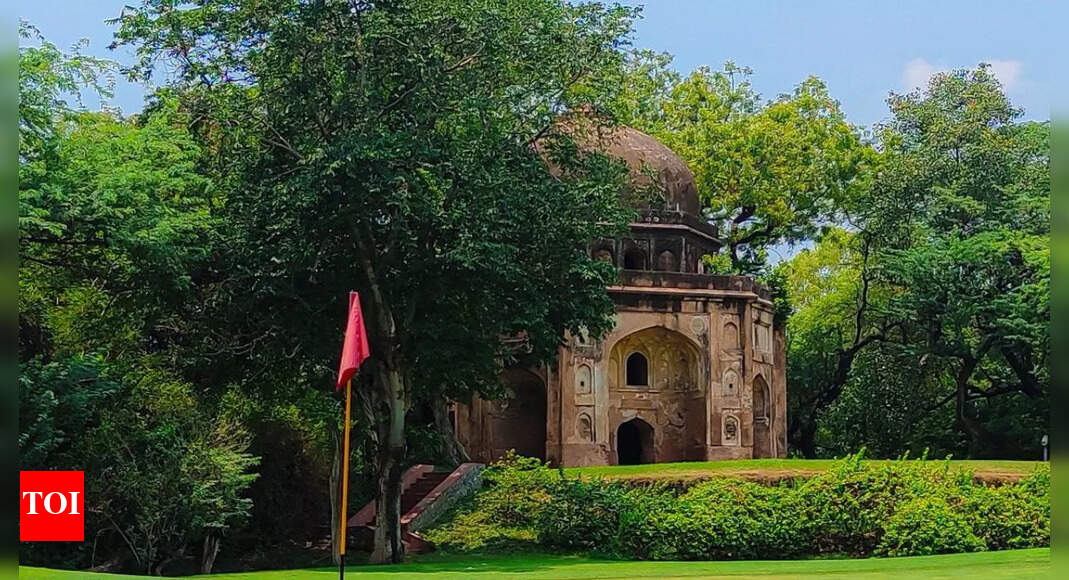 New Delhi: Culture lives quietly at the Delhi Golf Club, hidden between shadows of neem trees and red sandstone domes, in the hush of a golf club swing and the echo of a peacock’s call. It’s not just a golf course; it’s a dialogue between sport and history. As the DP World India Championship comes to the Capital under a mild October sun, the culture of the DGC — refined, rhythmic, and rooted in India’s past — rises to the fore once again. Few sporting venues anywhere in the world breathe heritage the way DGC does. Its very soil carries centuries of culture — the legacy of Delhi’s earliest, from the Lodis to the Mughals, who once built their gardens, mosques and tombs on these same grounds. Walk its fairways, and you pass through more than bunkers and roughs; you pass through time. The course winds through an open-air museum of medieval Delhi, a landscape scattered with red-brick domes, arched tombs, and crumbling walls that rise quietly behind the greens. When the sun filters through amaltas leaves in October and lays a golden sheen across the course, the fusion feels divine. For some of the visiting golfers, teeing off here has been an experience beyond the ordinary. “Got to see five holes on the course and hit some balls on the range and got warmed up. It’s very nice, quite surreal. It has a cool feel, especially seeing some of the old buildings, domes, and some ruins and stuff. I think that’s really cool. There is kind of a culture attached to it. It kind of gives me a little bit of a Mayakoba (golf course in Mexico) feel, and I’ve had some success there, so already good vibes being here,” Norwegian golfer Viktor Hovland, the former world number 3, said. “I’ve travelled around the world quite a lot with golf but never been to India. When I had the opportunity to come, it seemed like a great opportunity, a couple of weeks after the Ryder Cup… to come and experience this wonderful country. There is a different feel to this course. Being here, there is history, emotion, energy attached and that’s what is inspiring,” English golfer Luke Donald, a former world number 1, said. The DGC was founded in the 1930s. It remains a rare specimen in the world of sport where one can line up a 20-foot putt in the shadow of a 15th-century tomb.For the pros arriving for the DP World India Championship, the course is both a test of skill and a test of temperament. It’s not long, but it’s demanding — precision over power, patience over aggression. Every shot here must be plotted like a chess move. A stray drive can vanish into dense rough or brush up against the roots of a jamun tree. “I’m not going to try to look in the trees too much, hopefully. I’m going to try to stay away from the bushes,” Hovland quipped. Talking about his strategy over the week, the 28-year-old said, “You’ve got to hit the ball straight. You can all see the fairway and the green, it’s right there.” “It’s a very challenging golf course being so narrow and different grass types and all of that. I’m sure the natives here will feel a little bit more comfortable, but at the end of the day you’ve got to hit the shots and make the putts,” he quickly added. “A very unique golf course. You’ve got to plot your way around a course like this,” Donald added. Now, as the DP World Tour descends upon Delhi, DGC becomes more than a venue — it becomes a cultural moment. The world’s best golfers will chase birdies under the gaze of domes, their swings framed by silhouettes that once defined imperial Delhi.
New Delhi: Culture lives quietly at the Delhi Golf Club, hidden between shadows of neem trees and red sandstone domes, in the hush of a golf club swing and the echo of a peacock’s call. It’s not just a golf course; it’s a dialogue between sport and history. As the DP World India Championship comes to the Capital under a mild October sun, the culture of the DGC — refined, rhythmic, and rooted in India’s past — rises to the fore once again. Few sporting venues anywhere in the world breathe heritage the way DGC does. Its very soil carries centuries of culture — the legacy of Delhi’s earliest, from the Lodis to the Mughals, who once built their gardens, mosques and tombs on these same grounds. Walk its fairways, and you pass through more than bunkers and roughs; you pass through time. The course winds through an open-air museum of medieval Delhi, a landscape scattered with red-brick domes, arched tombs, and crumbling walls that rise quietly behind the greens. When the sun filters through amaltas leaves in October and lays a golden sheen across the course, the fusion feels divine. For some of the visiting golfers, teeing off here has been an experience beyond the ordinary. “Got to see five holes on the course and hit some balls on the range and got warmed up. It’s very nice, quite surreal. It has a cool feel, especially seeing some of the old buildings, domes, and some ruins and stuff. I think that’s really cool. There is kind of a culture attached to it. It kind of gives me a little bit of a Mayakoba (golf course in Mexico) feel, and I’ve had some success there, so already good vibes being here,” Norwegian golfer Viktor Hovland, the former world number 3, said. “I’ve travelled around the world quite a lot with golf but never been to India. When I had the opportunity to come, it seemed like a great opportunity, a couple of weeks after the Ryder Cup… to come and experience this wonderful country. There is a different feel to this course. Being here, there is history, emotion, energy attached and that’s what is inspiring,” English golfer Luke Donald, a former world number 1, said. The DGC was founded in the 1930s. It remains a rare specimen in the world of sport where one can line up a 20-foot putt in the shadow of a 15th-century tomb.For the pros arriving for the DP World India Championship, the course is both a test of skill and a test of temperament. It’s not long, but it’s demanding — precision over power, patience over aggression. Every shot here must be plotted like a chess move. A stray drive can vanish into dense rough or brush up against the roots of a jamun tree. “I’m not going to try to look in the trees too much, hopefully. I’m going to try to stay away from the bushes,” Hovland quipped. Talking about his strategy over the week, the 28-year-old said, “You’ve got to hit the ball straight. You can all see the fairway and the green, it’s right there.” “It’s a very challenging golf course being so narrow and different grass types and all of that. I’m sure the natives here will feel a little bit more comfortable, but at the end of the day you’ve got to hit the shots and make the putts,” he quickly added. “A very unique golf course. You’ve got to plot your way around a course like this,” Donald added. Now, as the DP World Tour descends upon Delhi, DGC becomes more than a venue — it becomes a cultural moment. The world’s best golfers will chase birdies under the gaze of domes, their swings framed by silhouettes that once defined imperial Delhi.







